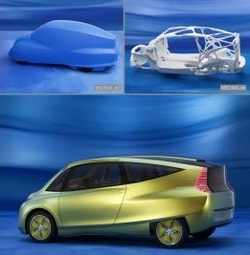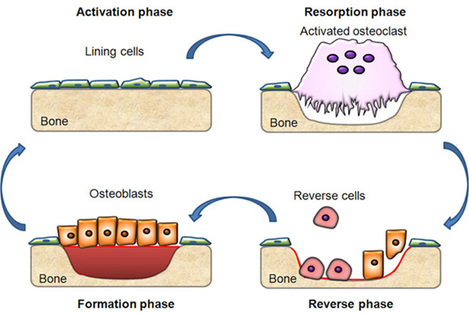|
by Denise Croote '16  Although seemingly static, bones are actually very dynamic structures that undergo constant growth. In fact, turnover is so frequent in bone cells that the skeletal system of a young healthy individual is completely replaced every four years (1). Not only are they dynamic, but bones are also exceedingly efficient when it comes to conserving materials. In the body, increasing material mass comes at a high metabolic cost, so bones confine themselves to areas where structural support is absolutely necessary. This “less is more” philosophy has caught the eye of the automobile industry, for eliminating redundant material when designing vehicles is not only cost-effective, but also environmentally friendly. Bones undergo a process called remodeling in response to stress. In our bodies high stress induces the activity of fibroblasts (osteoblasts), cells that lay down bone material. This deposition occurs in areas that undergo heavy repetitive loads, like the femur for instance, which supports the weight of the body with every step. Alternatively, less bone growth occurs in areas accustomed to lighter loads. Low stress induces the activity of osteoclasts, a different cell type that dictates when and where bone resorption occurs. They achieve this resorption by breaking down bones and releasing minerals, mainly calcium, into the blood stream (2). Thankfully, our vehicles do not break themselves down and release metal into the road as we are driving (for the most part), but nonetheless, this concept of functional material allocation is of particular interest to GM and Mercedes-Benz. So how do bones sense heavy and light loads and can this technique be applied to vehicle design? Bones are piezoelectric, meaning that mechanical stress induces an electric charge, and can use this unique property to determine which areas are undergoing the most stress. This is accomplished by monitoring the accumulation of electric charges in certain areas of bone. When a lot of charge is accumulated, fibroblasts deposit more bone, thus enhancing the support of the vulnerable area.  Remodeling strengthens bones that are consistently subject to mechanical stress. [image via] Currently, GM and Mercedes-Benz are engineering car and chair parts that use stress-analyzing technology to distribute steel in areas of high stress to parallel the efficiency that is seen in bones. They are using finite element analysis, which is a computational modeling technique that analyzes stress and strain, to produce a stable solution. The software takes a bulky car part, for example, an engine bracket, and remodels it based on how a bone would respond if it were subject to the same stresses. The program outputs an optimally designed part that GM and Mercedes Benz can then use in the manufacturing process (3). By depositing steel only where structurally necessary, GM and Mercedes-Benz are maximizing support while minimizing material use. One of the main advantages to this technique is that it produces lighter more fuel-efficient automobiles without sacrificing structural integrity (3). This is both environmentally friendly and cost-effective, a claim supported by the Department of Energy, which states that reducing a vehicle’s weight by 10% can improve fuel economy by 6 to 8% (4). The video below, which features and interview with Lother Harzheim, Project Engineer at GM Europe, demonstrates how this technology can significantly reduce the bulk of both car parts and chairs! References:
0 Comments
Leave a Reply. |
